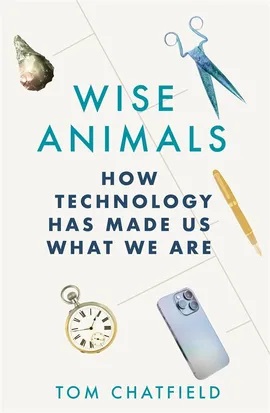This example comes from technology historian David Nye, but he makes a point that recurs in Tom Chatfield's excellent book. Any technology is part of the story. This applies to chimpanzees, whose story is implicit. This remains true in the high-tech 21st century, when a commercial for the latest phone model is a 20-second story about how to turn your life into countless flawless videos of smiling people enjoying perfect moments.
Nowadays, of course, stories are more explicitly driven, and the future they herald is often contested. It is therefore important to establish some principles for thinking about technology. We may realize that leaving technology to the market means that we will get new technology that increases profits rather than actually improves lives. But acting on it means coming to grips better with how the human-made world is a composite of stories and machines: that is, embodied imagination.
Chatfield, a technology journalist with an interest in philosophy, is an excellent terrain guide. His definition of technology is very broad – “the totality of human artifacts that expand our understanding of the world” – and he wants to go beyond the persistent tendency to see technology as merely the next wave of innovation, when those inventions and devices we make were merely “things “.
These two starting points mean that his book wanders through the entirety of human history, and even before that. It charts how we have shaped our environment, since the adoption of fire and flint, and how it has reshaped us since. Humans and their technologies are in a constantly unfolding dance, and the co-production that ensues is both cognitive and material. Writing is technology. The same applies to map making. Your smartphone, when looked at properly, is an extension of your mind, not just a hand-held gadget.
All of this is covered in the first half of the book. Because Chatfield's subtitle sells what it offers in two ways. His view, based on reading all thoughtful technology commentators, is far more complex and satisfying than “technology made us who we are.” He is interested in where we let technology take us next, not just how we got there.
 His examination of this in Part II is less comprehensive. This has to be the case, as the possibilities offered by technology grow. Old technologies are constantly enabling new technologies, and are being recombined in new ways. The sometimes startling ramifications of this combined cultural and technological development are exhilarating and disconcerting in equal measure.
His examination of this in Part II is less comprehensive. This has to be the case, as the possibilities offered by technology grow. Old technologies are constantly enabling new technologies, and are being recombined in new ways. The sometimes startling ramifications of this combined cultural and technological development are exhilarating and disconcerting in equal measure.
Chatfield's approach to future technology focuses mainly on the electronic sphere – computers, connectivity, artificial intelligence, self-driving cars, etc. There is help from psychology, neuroscience, and cognitive science to help us get our bearings. It continues to use the principles it established previously, with some new ones.
The book is designed to look like one of those “here's a big idea that explains all of human history” efforts, but Chatfield is too thoughtful and meticulous a writer to make another such effort. In fact, he pins each chapter on an idea about technology that he insists is false, or an illusion as he calls it. This constant polemic against certain propositions gives the text a slightly negative character, but the more complex point of view he builds is really necessary to even begin to do justice to its subject. He usually succeeds in following his own advice, with only a few lapses. For example, he rejects the popular idea that we will unite with, or subsume under, our technologies in some kind of posthuman transcendence. However, he still seems to fall into the trap of the “illusion of perpetual progress” rhetoric when he writes that “we have embarked on an accelerating path toward something unprecedented.” Could the Singularity loom after all?
However, it is his general insistence that the form technology takes is not predetermined, and that its consequences are never inevitable, that is most important. It is clear that even when we avoid too simple technological determinism, it is essential to recognize that values, goals, and relationships can—and often are—embedded in new technologies early in development, and can be difficult to change.
Again, this is a point emphasized mainly by examples from current developments in computing and data processing. There is a lot to worry about here, although more in other areas would have increased the book's appeal. There's not much here about the energy systems we currently need to completely rebuild, for example, or about weapons, and hardly anything about the life sciences.
This omission is justified, if only because there are so many books about these things. It seems to me that the other two are more serious. He doesn't really relish the idea that technologies might take forms derived from human psychopathology. There seems to be a default assumption here that people have basically good intentions. But the possibilities that advanced technologies offer to those whose main goal is to control others, or even destroy entire society, raise little concern. Perhaps Chatfield is too mild-mannered to indulge in the dark horizons that such consideration would require.
It also, most disappointingly, fails to give us much about how we can participate in shaping our technological future. He explains the need for a new ethics of technology, with a whole chapter on what kind of ethics should be followed. But it is not clear how it can be adopted at all. Yes, we need to improve our ability to create “virtuous cycles” of technology development. but how?
The book does ask this question, but it includes only a few examples that might help answer it. A brief description of how the Algorithmic Justice League grew out of one MIT graduate student's realization that facial recognition systems harbor racial bias is about as descriptive as it gets. Chatfield hopefully points to “deliberate delay, opposition, and disavowal” as options, and suggests that they should be placed on solid foundations. But there are a few pointers here on how to activate it usefully. The problem, perhaps insurmountable, is that most of us – workers, citizens and consumers – have little access to technology at its inception, or ways to influence its course. It is not clear that we have thought of any better techniques to do this as modern technological trajectories have accelerated in the past few hundred years. A copy of my proof Wise animals It lacks an index, but if there is any discussion of the Luddites I have missed it.
@John and Turney

